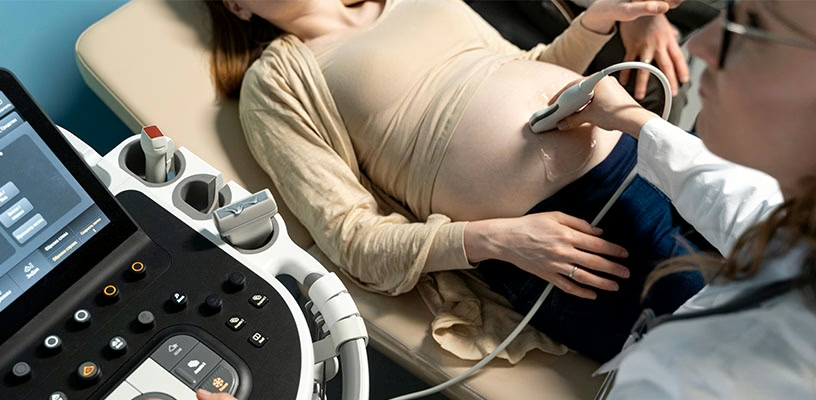Can the Ramzi Theory Really Predict Your Baby’s Sex?
If you’re like many moms-to-be, you’re eager to learn your baby’s sex as soon as possible. Some people claim that before medical science can determine the sex, you can get a sneak peek using something called the Ramzi theory.

Supposedly, the Ramzi theory works as early as six weeks into your pregnancy. 1 But what exactly is this method, and does it actually work as advertised? Read on to learn more and find out how to try it for yourself.
What is the Ramzi method?
Again, the Ramzi theory (which is also known as the Ramzi method) claims that you can predict your baby’s sex as early as week six of pregnancy by analyzing the location of the chorionic villi—tiny, finger-like projections on the placenta—on an ultrasound image.
According to this theory, if you’re looking for signs of having a boy or girl, the answer lies in your placenta’s location. If it’s on the right side of your uterus, you’re probably having a boy. Conversely, you’ll likely have a girl if your placenta is on the left side.
Is the Ramzi theory legit?
The short answer is no. Unfortunately, no solid scientific evidence supports the Ramzi method’s ability to predict your baby’s sex.
There are plenty of reasons to be skeptical about this method. Again, no reputable, peer-reviewed medical journal published Ramzi’s research. Since it didn’t undergo scrutiny by other experts in the field, the Ramzi theory’s scientific validity hasn’t been established.
Who developed the Ramzi method?
Dr. Saad Ramzi Ismail first published a paper on this method in 2011 on ObGyn.net, an online community for medical professionals. It’s worth noting that Ramzi is not a medical doctor (although he does hold a doctorate in Public Health) and did not publish his paper in a medical or academic journal, which means it was not peer-reviewed.
Countervailing evidence
Some studies have actively called the Ramzi theory into question.
An Australian study published in Ultrasound in Obstetrics & Gynecology tested the Ramzi theory and found no correlation between placental location and fetal sex. 2
Major medical organizations like the American College of Obstetricians and Gynecologists (ACOG) don’t recognize the Ramzi theory as a valid method to predict your baby’s sex.
The Ramzi theory is just one of many non-scientific ways to try to predict your baby’s sex as early as possible. You may have seen others, including the Chinese gender predictor chart (which purports to determine your baby’s sex with your lunar age and conception month), the nub theory (which looks at the “angle of the dangle” to determine genitalia), or at-home DIY tests like mixing your urine with salt or baking soda.
While these methods can be fun to read about, they aren’t reliable. 3 Most simply have no scientific validity at all. Nub theory is the exception, but even that method is difficult or impossible to actually put into practice.
Unfortunately, the only real way to determine your baby’s sex is to consult with your doctor. We’ll outline when and how you can do this below.
How to try the Ramzi method
Just to reiterate, the Ramzi method isn’t a real way of determining your baby’s sex. Still, if you’re curious, here’s how you could (hypothetically) try it out.
1. Schedule an early ultrasound
To try this method, you’d need to schedule a pregnancy ultrasound earlier than you normally would. You’d need to have an ultrasound done between week six and week eight of your pregnancy.
2. Ask the sonographer which side your placenta is located on
During your ultrasound, you’d also need to ask the sonographer which side of your uterus the placenta is forming on.
Note that sonographers don’t typically perform this assessment—your placenta typically spreads flat across your uterus during early pregnancy, and it might be difficult to determine its exact location. This is another hurdle that would make the Ramzi method impractical even if it did have a solid scientific foundation (which, again, it doesn’t).
3. Interpret the results
Allegedly, if your placenta is on the right, you’re having a boy, while left-side placental placement suggests you’re having a girl.
Some moms-to-be like to post their early ultrasound photos to online gender prediction groups and ask for opinions from other expecting parents based on the Ramzi theory.
Remember that any results you get from the Ramzi method—or any other early prediction method you try—are purely for entertainment. Don’t make any decisions (like what types of baby clothes to buy) based on this unproven method.
What are reliable ways for determining your baby's sex?
If you want to find out whether you’re having a boy or a girl before birth, there are several medically sound ways to do so.
Non-invasive prenatal testing
Doctors usually perform non-invasive prenatal testing (NIPT) after 10 weeks. This blood test screens for chromosomal abnormalities and can accurately determine your baby’s sex with 99% accuracy. 4
Mid-pregnancy ultrasound (the anatomy scan)
A sonographer usually performs a mid-pregnancy ultrasound between week 18 and week 22. This is known as the anatomy scan (or “gender scan“) because this is around the time when it’s possible to see your baby’s developing genitals on an ultrasound, provided your baby is in a position that affords clear line-of-sight to that area. 5 6
Because almost all moms-to-be get the anatomy scan, in most pregnancies, week 18 is when you’ll learn your baby’s sex (assuming you want to be told). The other procedures on this list aren’t universal, so if they allow you to find out early, that’s a nice freebie, but not something you should count on.
Chorionic villus sampling and amniocentesis
Chorionic villus sampling (CVS) and amniocentesis are invasive diagnostic tests that are usually reserved for higher-risk pregnancies. Doctors use them to analyze babies’ genetic makeup for abnormalities, and they can also reveal the baby’s sex with high accuracy. 7 This is possible after week 10 (with CVS) and week 15 (for amniocentesis) of your pregnancy.
Amniocentesis and CVS are generally safe procedures, but they do come with small but real associated risks of miscarriage, infection, bleeding, and other complications. 8 That’s why doctors only perform them when it’s truly necessary—you can’t get one just because you’re antsy to find out your baby’s sex a little early.
Final thoughts
If you’re trying to figure out your baby’s sex early on in pregnancy, the Ramzi method won’t cut it. Of course, if you’re just looking for a fun little diversion to take your mind off those frustrating early pregnancy symptoms, then go for it—but to really learn your baby’s sex, you’ll need to wait a few more weeks.
Article Sources
- Medical News Today. "What is the Ramzi theory?" Retrieved May 7, 2025.
- International Society of Ultrasound in Obstetrics and Gynecology. "P18.17: The role of placental location assessment in the prediction of fetal gender" Retrieved May 7, 2025.
- Paediatric and Perinatal Epidemiology. "Accuracy of the Chinese lunar calendar method to predict a baby's sex: a population-based study" Retrieved May 7, 2025.
- MedlinePlus. "What is noninvasive prenatal testing (NIPT) and what disorders can it screen for?" Retrieved May 7, 2025.
- MedlinePlus. "Ultrasound pregnancy" Retrieved May 7, 2025.
- American College of Obstetricians and Gynecologists. "Ultrasound Exams" Retrieved May 7, 2025.
- MedlinePlus. "Chorionic Villus Sampling (CVS)" Retrieved May 7, 2025.
- MedlinePlus. "Amniocentesis" Retrieved May 7, 2025.







